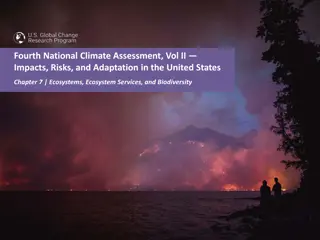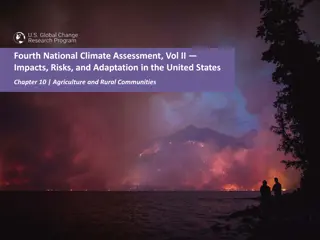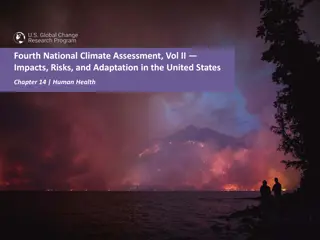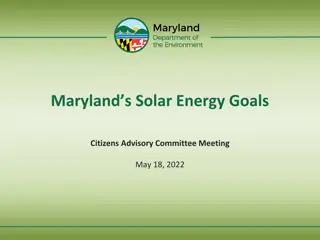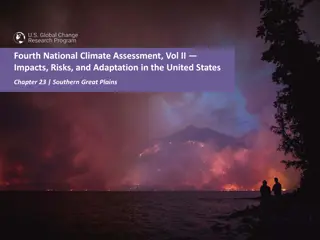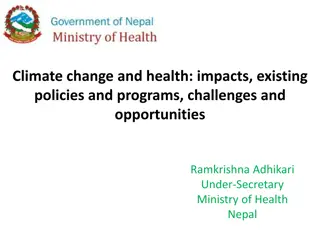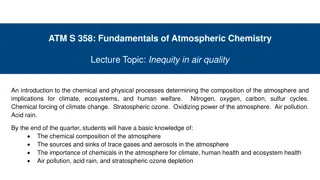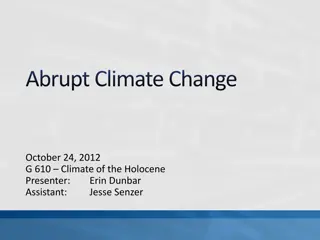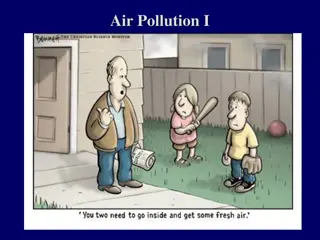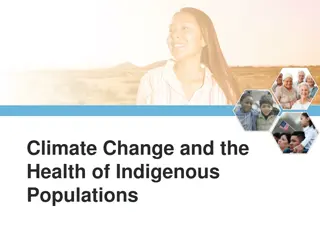Impacts of Climate Change on Air Quality and Health in the United States
The Fourth National Climate Assessment, Vol. II, highlights the increasing risks from air pollution in the United States, impacting over 100 million people in communities where air quality exceeds health-based standards. Climate change worsens air pollution levels, leading to adverse health effects, environmental consequences, and increased wildfire impacts. Changes in climate also contribute to higher airborne allergen exposure, threatening respiratory health. Mitigating greenhouse gas emissions presents co-benefits for both climate change and air quality improvement.
Download Presentation

Please find below an Image/Link to download the presentation.
The content on the website is provided AS IS for your information and personal use only. It may not be sold, licensed, or shared on other websites without obtaining consent from the author. Download presentation by click this link. If you encounter any issues during the download, it is possible that the publisher has removed the file from their server.
E N D
Presentation Transcript
Fourth National Climate Assessment, Vol II Impacts, Risks, and Adaptation in the United States Chapter 13 | Air Quality Fourth National Climate Assessment, Vol II Impacts, Risks, and Adaptation in the United States nca2018.globalchange.gov 1
Ch. 13 | Air Quality Key Message #1 13 Increasing Risks from Air Pollution More than 100 million people in the United States live in communities where air pollution exceeds health-based air quality standards. Unless counteracting efforts to improve air quality are implemented, climate change will worsen existing air pollution levels. This worsened air pollution would increase the incidence of adverse respiratory and cardiovascular health effects, including premature death. Increased air pollution would also have other environmental consequences, including reduced visibility and damage to agricultural crops and forests. Fourth National Climate Assessment, Vol II Impacts, Risks, and Adaptation in the United States nca2018.globalchange.gov 2
Ch. 13 | Air Quality Key Message #2 13 Increasing Impacts of Wildfires Wildfire smoke degrades air quality, increasing the health risks to tens of millions of people in the United States. More frequent and severe wildfires due to climate change would further diminish air quality, increase incidences of respiratory illness from exposure to wildfire smoke, impair visibility, and disrupt outdoor recreational activities. Fourth National Climate Assessment, Vol II Impacts, Risks, and Adaptation in the United States nca2018.globalchange.gov 3
Ch. 13 | Air Quality Key Message #3 13 Increases in Airborne Allergen Exposure The frequency and severity of allergic illnesses, including asthma and hay fever, are likely to increase as a result of a changing climate. Earlier spring arrival, warmer temperatures, changes in precipitation, and higher carbon dioxide concentrations can increase exposure to airborne pollen allergens. Fourth National Climate Assessment, Vol II Impacts, Risks, and Adaptation in the United States nca2018.globalchange.gov 4
Ch. 13 | Air Quality Key Message #4 13 Co-Benefits of Greenhouse Gas Mitigation Many emission sources of greenhouse gases also emit air pollutants that harm human health. Controlling these common emission sources would both mitigate climate change and have immediate benefits for air quality and human health. Because methane is both a greenhouse gas and an ozone precursor, reductions of methane emissions have the potential to simultaneously mitigate climate change and improve air quality. Fourth National Climate Assessment, Vol II Impacts, Risks, and Adaptation in the United States nca2018.globalchange.gov 5
Ch. 13 | Air Quality Fig. 13.1: Pathways by Which Climate Change Will Influence Air Pollution Climate change will alter (black bold text) chemical and physical interactions that create, remove, and transport air pollution (red text and gray arrows). Human activities and natural processes release precursors for ground-level ozone (O3) and particulate matter with a diameter less than 2.5 micrometers (PM2.5), including methane (CH4), carbon monoxide (CO), nitrogen oxides (NOx), non-methane volatile organic compounds (NMVOCs), sulfur dioxide (SO2), ammonia (NH3), organic carbon (OC), black carbon (BC), and dimethyl sulfide (DMS); and direct atmospheric pollutants, including mineral dust, sea salt, pollen, spores, and food particles. Source: adapted from Fiore et al. 2015.4Reprinted by permission of the publisher (Taylor & Francis Ltd., http://www.tandfonline.com). Fourth National Climate Assessment, Vol II Impacts, Risks, and Adaptation in the United States nca2018.globalchange.gov 6
Ch. 13 | Air Quality Fig. 13.2: Projected Changes in Summer Season Ozone The maps show the change in summer averages of the maximum daily 8-hour ozone concentration (as compared to the 1995 2005 average). Summertime ozone is projected to change non-uniformly across the United States based on multiyear simulations from the Community Multiscale Air Quality (CMAQ) modeling system. Those changes are amplified under the higher scenario (RCP8.5) compared with the lower scenario (RCP4.5), as well as at 2090 compared with 2050. Data are not available for Alaska, Hawai i, U.S.-Affiliated Pacific Islands, and the U.S. Caribbean. Source: adapted from EPA 2017.1 Fourth National Climate Assessment, Vol II Impacts, Risks, and Adaptation in the United States nca2018.globalchange.gov 7
Ch. 13 | Air Quality Chapter Author Team 13 Vaishali Naik, National Oceanic and Atmospheric Administration Robert W. Pinder, U.S. Environmental Protection Agency Tanya L. Spero, U.S. Environmental Protection Agency Darrell A. Winner, U.S. Environmental Protection Agency Lewis H. Ziska, U.S. Department of Agriculture Federal Coordinating Lead Author Christopher G. Nolte, U.S. Environmental Protection Agency Chapter Lead Christopher G. Nolte, U.S. Environmental Protection Agency Chapter Authors Patrick D. Dolwick, U.S. Environmental Protection Agency Neal Fann, U.S. Environmental Protection Agency Larry W. Horowitz, National Oceanic and Atmospheric Administration Review Editor David D Onofrio, Atlanta Regional Commission Fourth National Climate Assessment, Vol II Impacts, Risks, and Adaptation in the United States nca2018.globalchange.gov 8
Ch. 13 | Air Quality Acknowledgments 13 USGCRP Coordinators Ashley Bieniek-Tobasco, Health Program Coordinator Sarah Zerbonne, Adaptation and Decision Science Coordinator Christopher W. Avery, Senior Manager Fourth National Climate Assessment, Vol II Impacts, Risks, and Adaptation in the United States nca2018.globalchange.gov 9
Recommended chapter citation Nolte, C.G., P.D. Dolwick, N. Fann, L.W. Horowitz, V. Naik, R.W. Pinder, T.L. Spero, D.A. Winner, and L.H. Ziska, 2018: Air Quality. In Impacts, Risks, and Adaptation in the United States: Fourth National Climate Assessment, Volume II [Reidmiller, D.R., C.W. Avery, D.R. Easterling, K.E. Kunkel, K.L.M. Lewis, T.K. Maycock, and B.C. Stewart (eds.)]. U.S. Global Change Research Program, Washington, DC, USA. doi: 10.7930/NCA4.2018.CH13 Read the full chapter https://nca2018.globalchange.gov/chapter/air-quality nca2018.globalchange.gov Fourth National Climate Assessment, Vol II Impacts, Risks, and Adaptation in the United States nca2018.globalchange.gov 10









